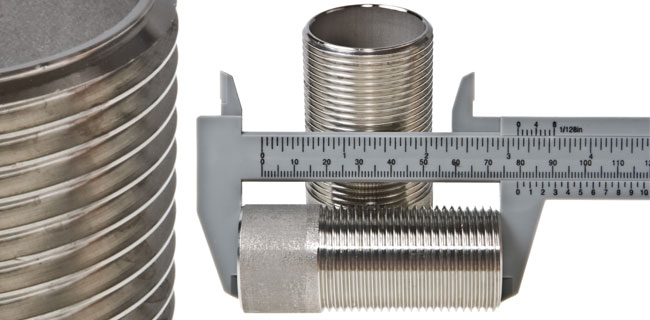Have you ever ordered the wrong pipe size and wondered what happened? You measured the pipe threads. In fact, you measured it a few times before placing your order, but once your order arrives and you go to use pipe, it doesn’t fit. Well, measuring pipe threads seems simple enough, but it can be deceivingly complicated. A few tweaks in how you measure pipe threads could make all the difference- and save time and frustration.
The most common threads used in general applications, follow the American National Standard Pipe Thread standards, or national pipe thread (NPT).
They include both tapered threads, used on fasteners and pipe and straight thread series.
Tapered threaded pipes, often used in plumbing installations for the delivery of fluids or steam have a threaded section that is shaped like a cone. This design forms a seal when torqued, as the flanks of the threads compress against each other
Straight thread fittings connect piping, but do not provide the seal alone. Straight threads can be sealed into a female pipe with Teflon tape or pipe compound. Read below for measuring advice specific to NPT.
Contact us today to discuss your needs or to schedule an onsite consultation at 314-638-6500 option 4.
The rule of thumb when measuring National Pipe Thread is to subtract ¼-inch from your initial measurement. The thickness of the pipe wall will vary depending on the pipe, so always take that into account.
Here’s an example: To measure the threads on a ¼ inch male pipe thread (MPT), measure the very outsides of the thread, then subtract ¼ inch of the outside diameter (OD) measurement to account for the thickness of the pipe wall on either side. When measuring a female pipe thread (FPT), measure the OD of the pipe itself and subtract ¼ inch to find the correct pipe thread size.
Perhaps even easier than this is to purchase a measuring tool called a caliper that will measure OD and inside diameter (ID). Eaton Weatherhead offers an angle gauge caliper and thread pitch gauge to help.
Check out the chart below for guidance on measuring National Pipe Threads (NPT). For additional guidance on other pipe threads, please view this reference guide from Eaton Weatherhead.
National Pipe Tapered (NPT) Thread Chart
Measure thread diameter and subtract 1⁄4 inch to find the nominal pipe size.
| Inch Size | Dash Size | Nominal Thread Size | Male Thread O.D. (in) | Female Thread I.D. (in) |
| 1/8 | 02 | 1⁄8 -27 | .39 | .33 |
| 1/4 | 04 | ¼-18 | .52 | .44 |
| 3/8 | 06 | 3/8 -18 | .65 | .58 |
| 1/2 | 08 | ½ -14 | .81 | .70 |
| 3/4 | 12 | 3⁄4-14 | 1.02 | .92 |
| 1 | 16 | 1- 11 ½ | 1.28 | 1.16 |
| 1 1/4 | 20 | 1 1⁄4-11 ½ | 1.62 | 1.50 |
| 1 1/2 | 24 | 1 1⁄2-11 ½ | 1.86 | 1.73 |
| 2 | 32 | 2-11 1⁄2 | 2.33 | 2.22 |
Additional Common Pipe Thread Acronyms
| NPT | National Pipe Thread (tapered) |
| FPT | Female Pipe Thread (interchangeable with NPT) |
| FIP | Female Iron Pipe (interchangeable with NPT) |
| MPT | Male Pipe Thread (interchangeable with NPT) |
| MIP | Male Iron Pipe (interchangeable with NPT) |
| IPS | Iron Pipe Size (interchangeable with NPT) |
| PTF | SAE Short Taper Pipe Thread |
| NPTF | National Pipe Thread Fuel (American National taper pipe thread for dryseal pressure-tight joints) |
| NPSM | National Pipe Straight Mechanical (American National straight pipe thread for mechanical joints) |
| NPSI | American National Straight Intermediate Pipe Thread |
| GHT | Garden Hose Thread |
| NST | National Standard Thread (fire hose thread) |
| BSPT | British Standard Taper Pipe Thread (metric) |
Related: Pro Tips for Proper Selection of Hydraulic Hose End Connections
For non-NPT measuring, many people measure a pipe by the outside diameter. For example, you draw a measuring tape along the pipe’s diameter and see a 1-inch measurement. It stands to reason you would then order a 1-inch pipe. However, you will be surprised when the fittings don’t match up. What you, in fact, need to order is a ¾-inch pipe because the chosen diameter should refer to the inside of the pipe where the potential flow happens, not the outside that was measured. Why? This accounts for the thickness of the pipe wall. So, just remember to focus on the interior diameter.
Contact us today to discuss your needs or to schedule an onsite consultation at 314-638-6500 option 4.
Superior Industrial Supply carries the hydraulic hose supplies and industrial tools you need to keep your operations running smoothly. If we can’t get you what you need, we’ll help you find it. Stop in to our St. Louis location, or call 314-638-6500 option 4 and we’ll get you squared away today.

